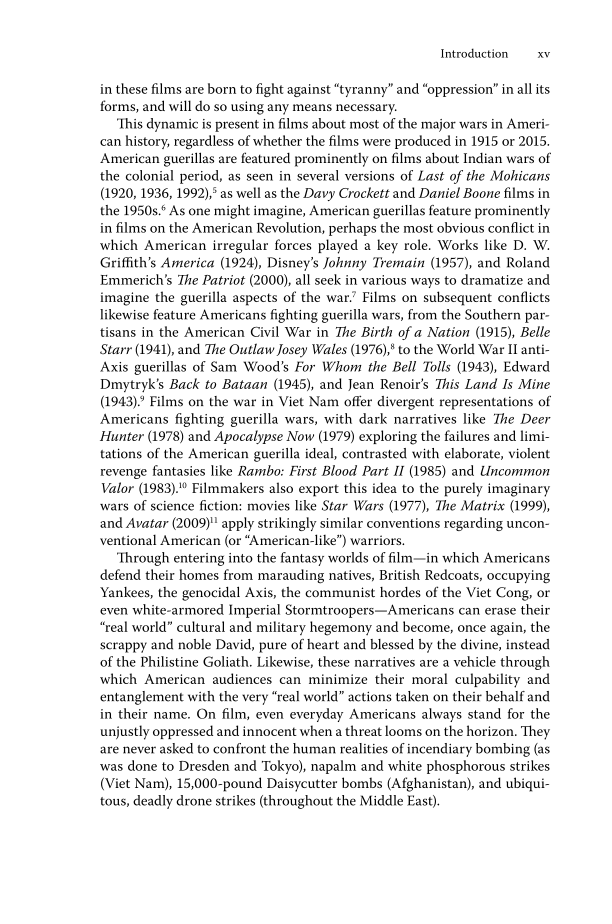Introduction xv in these fi lms are born to fi ght against “tyranny” and “oppression” in all its forms, and will do so using any means necessary. Th is dynamic is present in fi lms about most of the major wars in Ameri- can history, regardless of whether the fi lms were produced in 1915 or 2015. American guerillas are featured prominently on fi lms about Indian wars of the colonial period, as seen in several versions of Last of the Mohicans (1920, 1936, 1992), 5 as well as the Davy Crockett and Daniel Boone fi lms in the 1950s. 6 As one might imagine, American guerillas feature prominently in fi lms on the American Revolution, perhaps the most obvious confl ict in which American irregular forces played a key role. Works like D. W. Griffi th’s America (1924), Disney’s Johnny Tremain (1957), and Roland Emmerich’s Th e Patriot (2000), all seek in various ways to dramatize and imagine the guerilla aspects of the war. 7 Films on subsequent confl icts likewise feature Americans fi ghting guerilla wars, from the Southern par- tisans in the American Civil War in Th e Birth of a Nation (1915), Belle Starr (1941), and Th e Outlaw Josey Wales (1976), 8 to the World War II anti- Axis guerillas of Sam Wood’s For Whom the Bell Tolls (1943), Edward Dmytryk’s Back to Bataan (1945), and Jean Renoir’s Th is Land Is Mine (1943). 9 Films on the war in Viet Nam off er divergent representations of Americans fi ghting guerilla wars, with dark narratives like Th e Deer Hunter (1978) and Apocalypse Now (1979) exploring the failures and limi- tations of the American guerilla ideal, contrasted with elaborate, violent revenge fantasies like Rambo: First Blood Part II (1985) and Uncommon Valor (1983). 10 Filmmakers also export this idea to the purely imaginary wars of science fi ction: movies like Star Wars (1977), Th e Matrix (1999), and Avatar (2009) 11 apply strikingly similar conventions regarding uncon- ventional American (or “American-like”) warriors. Th rough entering into the fantasy worlds of fi lm—in which Americans defend their homes from marauding natives, British Redcoats, occupying Yankees, the genocidal Axis, the communist hordes of the Viet Cong, or even white-armored Imperial Stormtroopers—Americans can erase their “real world” cultural and military hegemony and become, once again, the scrappy and noble David, pure of heart and blessed by the divine, instead of the Philistine Goliath. Likewise, these narratives are a vehicle through which American audiences can minimize their moral culpability and entanglement with the very “real world” actions taken on their behalf and in their name. On fi lm, even everyday Americans always stand for the unjustly oppressed and innocent when a threat looms on the horizon. Th ey are never asked to confront the human realities of incendiary bombing (as was done to Dresden and Tokyo), napalm and white phosphorous strikes (Viet Nam), 15,000-pound Daisycutter bombs (Afghanistan), and ubiqui- tous, deadly drone strikes (throughout the Middle East).
Document Details My Account Print multiple pages
Print
You have printed 0 times in the last 24 hours.
Your print count will reset on at .
You may print 0 more time(s) before then.
You may print a maximum of 0 pages at a time.


















































































































































































































































